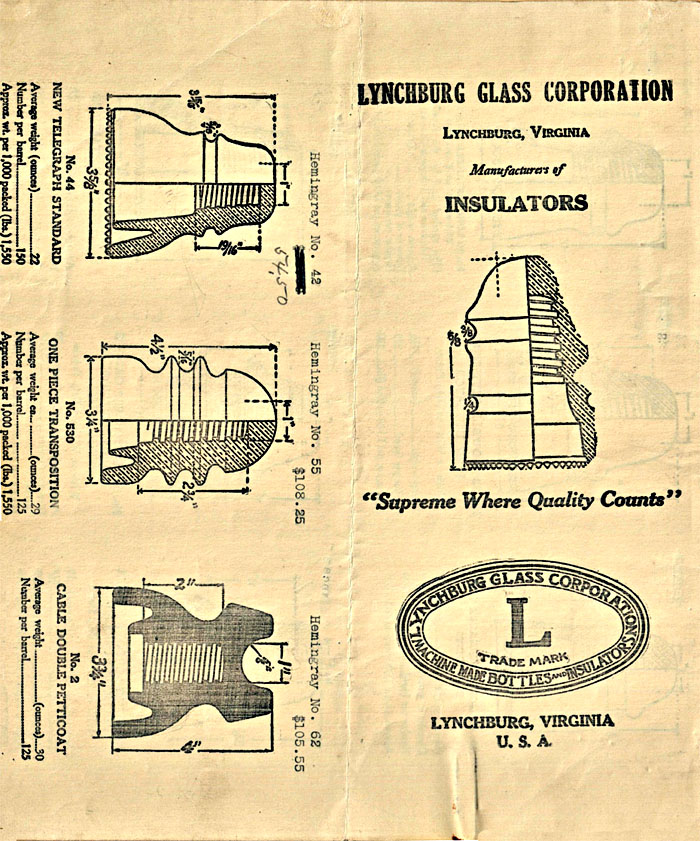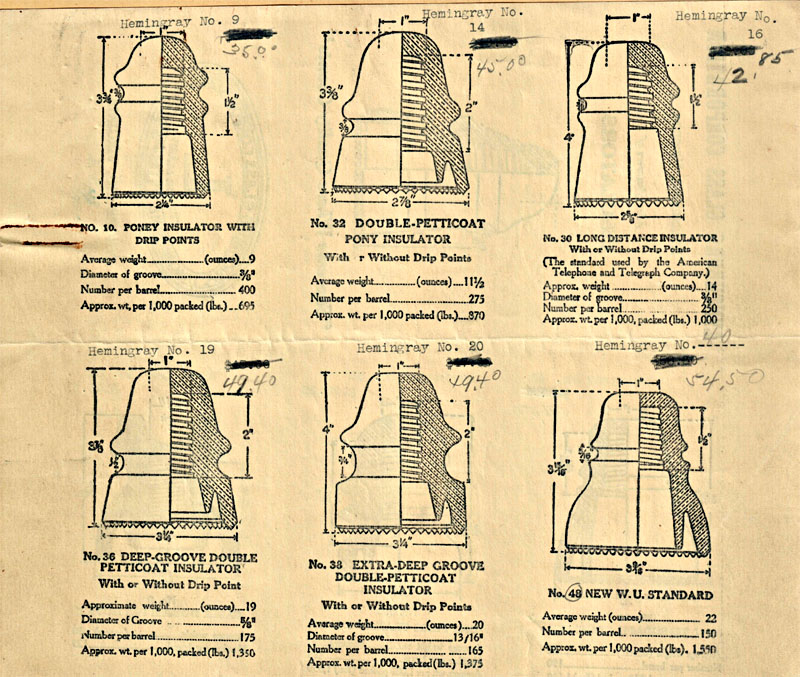Site Menu
Lynchburg Glass
Site Contents
CD Styles
Insulator Features
Mysteries
Anomalies
Production Data
Historical Archive
Gayner
Birmingham
|
Lynchburg Insulator Product Flyer, 1923 This is the first of only two known product "catalogs" used by Lynchburg. It is a single sheet of paper printed on both sides folded to fit into a standard business envelope (see photos below). The front contains the company name, slogan, and logo, while the rest includes cut-away illustrations of the available insulators with dimensions, approximate weight, number packed per barrel, and packed weight per thousand. Prices were made available on a separate sheet. While the flyer is not dated several things help us establish a date. There are only nine styles listed. Missing are the No. 31 (CD 112.1) and No. 43 (CD 145). These two styles were not put into production until the week ending January 12, 1924, which suggests the flyer predates that. -1- Also missing are No. 180 (CD 281) and No. 181 (CD 306) both of which would not be made until early 1925. The L in oval logo is the earlier version of the logo used in 1923 and very early 1924. There are penciled in prices, some of which have been marked out and corrected. The original prices correspond to a price list dated January 5, 1924. The new prices reflect the price list from April 1, 1924. Also, a complete business envelope from Lynchburg Glass Corporation exists postmarked December 22, 1923. On the reverse of the envelope is printed the right front page of this flyer (see photos below). -2- These factors suggest that the product flyer dates to late 1923. Most likely, it was the first product catalog used by Lynchburg when they began marketing insulators in November and December, 1923. Several other features are of interest. Hemingray style numbers and prices are typed onto the flyer. These were most likely for in-house use and would not normally have been mailed with this information on the flyer. Most of the illustrations seem to be taken from a Hemingray catalog. N. R. Woodward reported that a 1921 Hemingray catalog was among the records recovered from W. H. Loyd in 1959. -3- The No. 2 Cable (CD 252) illustration is taken from a Brookfield catalog, since Hemingray never made this style with this particular shape. The illustration of the No. 48 remains somewhat of a mystery. The illustration is of a CD 152. The typed notation to correspond with Hemingray's style number was originally left blank, which perhaps shows that even Lynchburg was not quite sure how to designate this style. The Hemingray style "40" that was penciled in was a CD 152. Yet, Lynchburg never made any CD 152s. They did have molds from Gayner for CD 153 which carried the Gayner style No. 48-400, a combination of Brookfield (No. 48) and Hemingray (No. 40) designations. Even though Hemingray's No. 40 was a CD 152, it is obvious that Gayner saw their CD 153 No. 48-400 as equivalent. So it seems likely that Lynchburg's No. 48 was a CD 153 made from reworked Gayner molds (see The Elusive No. 48). The illustration of Lynchburg's No. 44 (CD 154) uses the same cut as the No. 48 with different dimensions. Evidently, Lynchburg did not have access to an illustration of the CD 154, which was not included in the 1921 Hemingray catalog they had, so made do with the illustration they did have. The illustration on the front cover depicts an odd combination of a Hemingray style CD 112 and another insulator. Lynchburg's CD 112.1 No. 31 was not yet in production and no information is given about it in the flyer. When the No. 31 was made beginning the week ending January 12, 1924, it would be of a considerably different shape than this illustration (see Origin of the Lynchburg CD 112.1). The second insulator resembles a CD 133 but appears to be an edited version of that style. Lynchburg never made an insulator resembling this style. While most of these insulator styles were offered either with or without drip points, it is interesting that the No. 10 (CD 106) is only listed with drip points. Even though No. 32 (CD 160) was listed as available without drip points, none are known in smooth base. The first production run of No. 32 is listed in the records as a No. 140. It is also interesting to note that the No. 10 is called a "poney" insulator. This is likely a typographical error since the No. 32 (CD 160) is labeled a "Double Petticoat Pony Insulator." A later flyer refers to the No. 10 as a "pony" insulator. Some of Lynchburg's early publicity and letterheads, as well as their early corporate logo (used here), mentions bottles. However, this flyer clearly identifies the company as "Manufacturers of Insulators." There is no record or evidence of Lynchburg Glass Corporation ever making bottles, although they did make canning jars for a short time in early 1925 (see Is It A Lynchburg?). Click on images below for a larger photo. Product Brochure Company Envelope
Notes 1. The flyer also depicts No. 530 (CD 205) and No. 48 (CD 153), which were not made until the week ending January 19 and February 9, 1924. Since Lynchburg had Gayner molds for these, perhaps the plant intended to produce these in the first few weeks, and so were included in the product list, but they were not actually made until later. It is more likely that they were added to fill out the flyer with styles to show what was available without actually making them until a couple of months later, or until they had orders for those styles. 2. Information about this envelope courtesy Justin Stoudt. 3. Personal letter from N. R. Woodward, February 9, 1985: "The drawings are quite obviously copied from a 1921 Hemingray Catalog, which also was with the material from Lynchburg." |
Copyright © June 21, 2019 , Dennis Bratcher
Last modified: June 21, 2019 2:19 PM


 -
- 